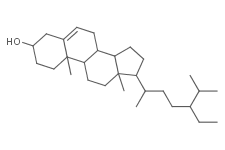
Beta-Sitosterol
CAS No. 83-46-5
Beta-Sitosterol( β-Sitosterol | 22,23-Dihydrostigmasterol )
Catalog No. M19156 CAS No. 83-46-5
β-Sitosterol has recently been shown to induce G2/M arrest, endoreduplication, and apoptosis through the Bcl-2 and PI3K/Akt signaling pathways.
Purity : >98% (HPLC)
 COA
COA
 Datasheet
Datasheet
 HNMR
HNMR
 HPLC
HPLC
 MSDS
MSDS
 Handing Instructions
Handing Instructions
| Size | Price / USD | Stock | Quantity |
| 100MG | 180 | In Stock |


|
| 200MG | Get Quote | In Stock |


|
| 500MG | Get Quote | In Stock |


|
| 1G | Get Quote | In Stock |


|
Biological Information
-
Product NameBeta-Sitosterol
-
NoteResearch use only, not for human use.
-
Brief Descriptionβ-Sitosterol has recently been shown to induce G2/M arrest, endoreduplication, and apoptosis through the Bcl-2 and PI3K/Akt signaling pathways.
-
Descriptionβ-Sitosterol has recently been shown to induce G2/M arrest, endoreduplication, and apoptosis through the Bcl-2 and PI3K/Akt signaling pathways. β-Sitosterol, a main dietary phytosterol found in plants, may have the potential for prevention and therapy for human cancer. Although the exact mechanism of action of β-sitosterols is unknown, it may be related to cholesterol metabolism or anti-inflammatory effects (via interference with prostaglandin metabolism). β-Sitosterol induces apoptosis and activates key caspases in MDA-MB-231 human breast cancer cells.(In Vitro):Beta-Sitosterol is one of the most abundant dietary phytosterols. Beta-Sitosterol shows anticancer properties against breast cancer, prostate cancer, colon cancer, lung cancer, stomach cancer, ovarian cancer, and leukemia.
-
In VitroCell Cytotoxicity Assay Cell Line:MDA-MB-231 Concentration:16 μM Incubation Time:3 days Result:No cytotoxicity at 16 μM Apoptosis Analysis Cell Line:MDA-MB-231 Concentration:16 μM Incubation Time:5 days Result:Increased 33% apoptosis when assayed using 1×104 cells and a 6-fold increase in apoptosis when assayed using a smaller number of cells 5×103.Western Blot Analysis Cell Line:COLO 320 DM Concentration:15, 30, 60, 120 μM Incubation Time:24 h Result:Decreased β-catenin and PCNA expression.
-
In VivoAnimal Model:Colon cancer rats model Dosage:10, 20 mg/kg Administration:p.o., suspended in 0.1% CMC (1.0 mL)Result:Reduced the number of aberrant crypt and crypt multiplicity in a dose-dependent manner.Animal Model:Streptozotocin-induced hyperglycemia rats model Dosage:10, 15, 20 mg/kg Administration:p.o.Result:Increased insulin levels and decreased HbA1c levels.Improved pancreatic antioxidant levels and decreased LPO levels.
-
Synonymsβ-Sitosterol | 22,23-Dihydrostigmasterol
-
PathwayOthers
-
TargetOther Targets
-
RecptorPPL
-
Research AreaMetabolic Disease
-
Indication——
Chemical Information
-
CAS Number83-46-5
-
Formula Weight414.72
-
Molecular FormulaC29H50O
-
Purity>98% (HPLC)
-
SolubilityDMSO : < 1 mg/mL; H2O : < 0.1 mg/mL
-
SMILES[C@@H]1(O)CC2=CC[C@@H]3[C@@H]([C@]2(CC1)C)CC[C@]1([C@H]3CC[C@@H]1[C@@H](CC[C@H](C(C)C)CC)C)C
-
Chemical Name(24R)-Ethylcholest-5-en-3beta-ol
Shipping & Storage Information
-
Storage(-20℃)
-
ShippingWith Ice Pack
-
Stability≥ 2 years
Reference
1. Wong HS, et al. PhytOthers Res. 2014 Jul;28(7):999-1006.
molnova catalog



related products
-
Fenoldopam mesylate
Fenoldopam is a selective dopamine-1 receptor (DA1) agonist with natriuretic/diuretic properties. It lowers blood pressure through arteriolar vasodilation.
-
Syk Inhibitor II (hy...
Spleen tyrosine kinase (Syk) is a non-receptor tyrosine kinase that, upon phosphorylation, binds to immunoreceptor tyrosine-based activation motifs of FcRγ chains and mediates downstream signaling related to platelet function and inflammation.
-
MS1943
MS1943 is a first-in-class, orally bioavailable EZH2 selective degrader, with an IC50 of 120 nM.



 Cart
Cart
 sales@molnova.com
sales@molnova.com


